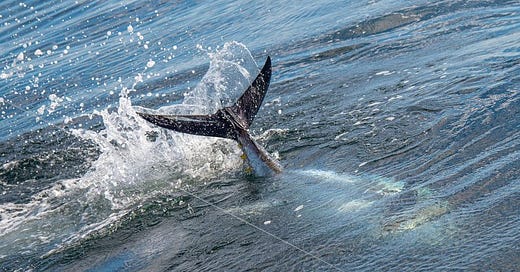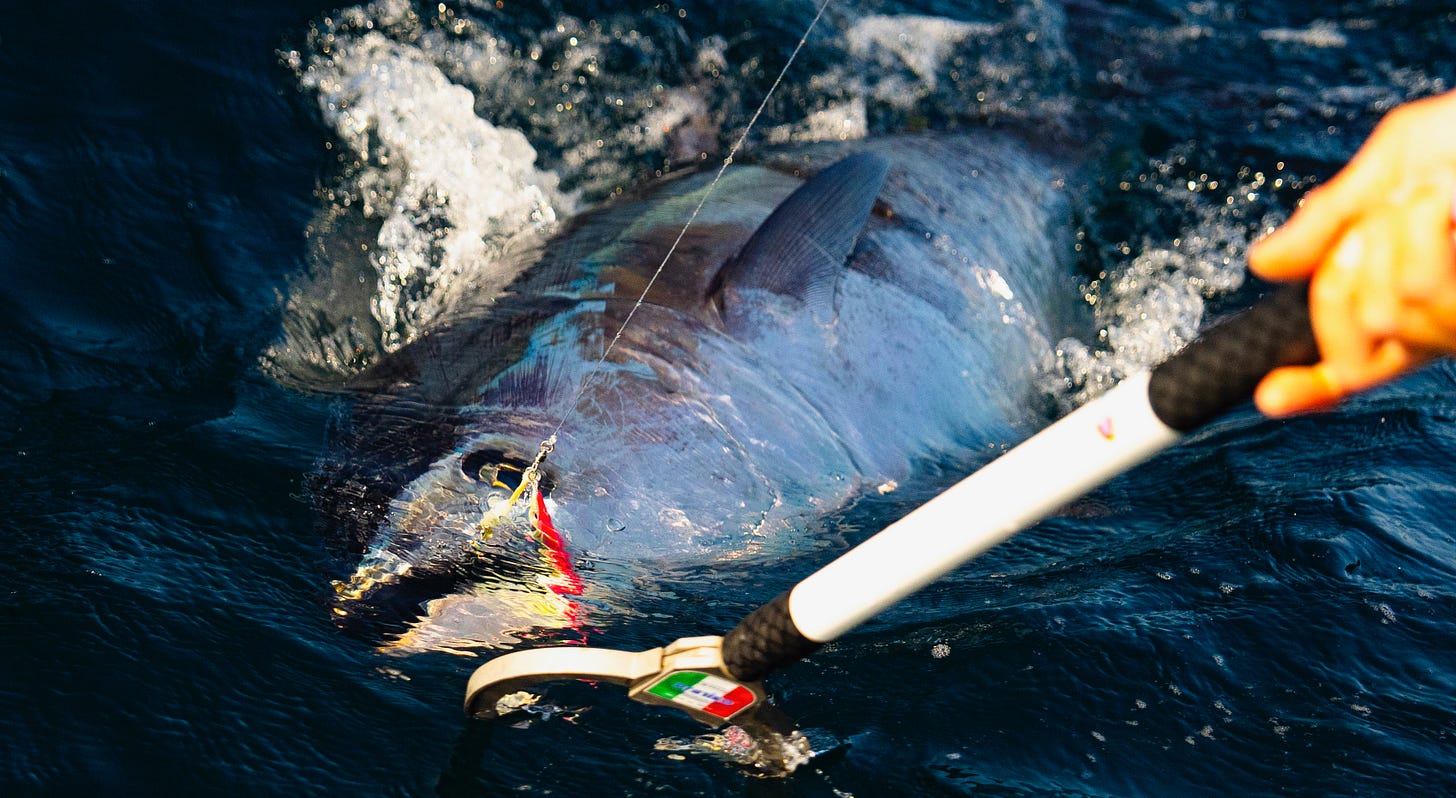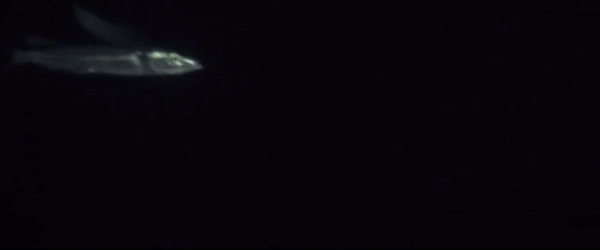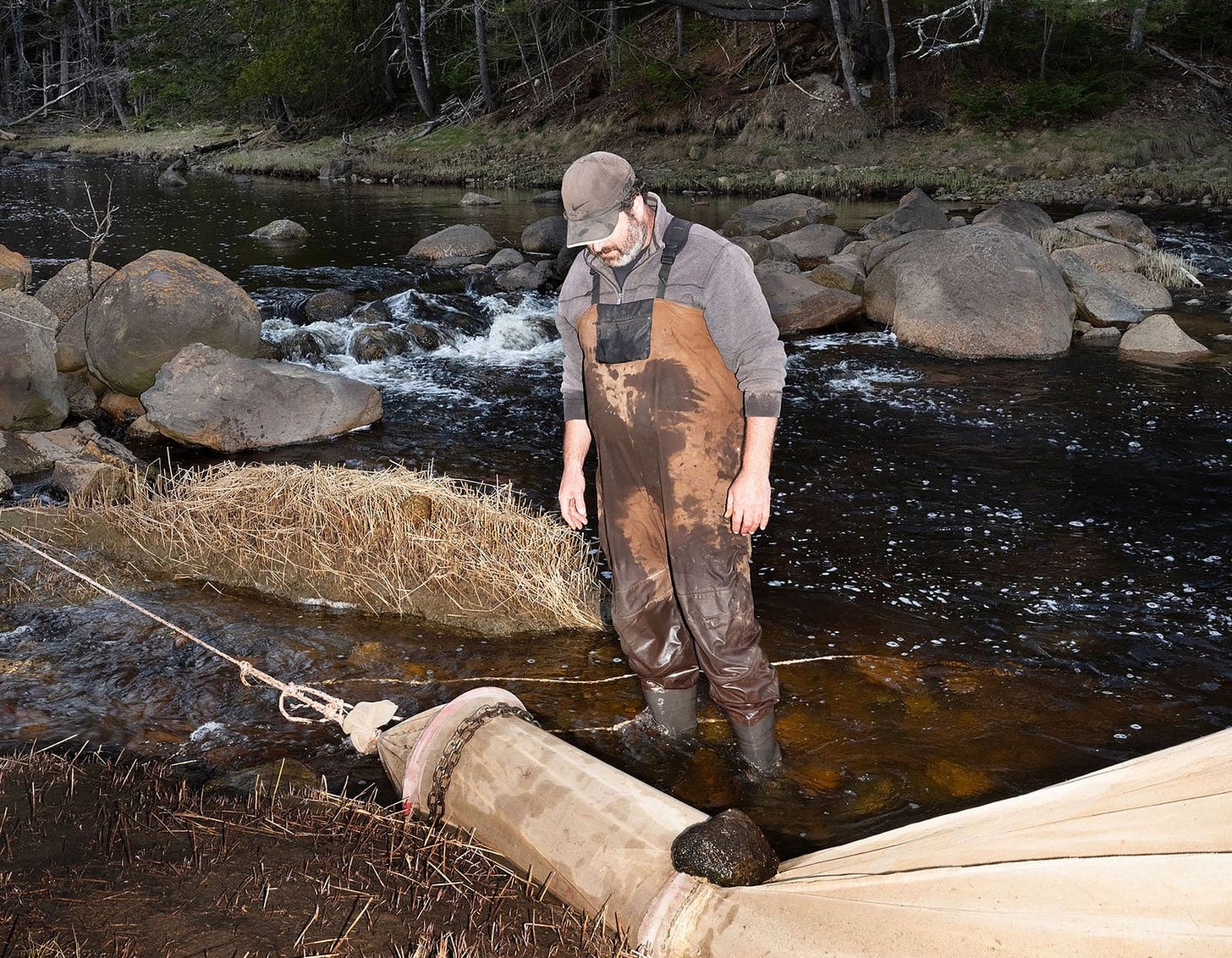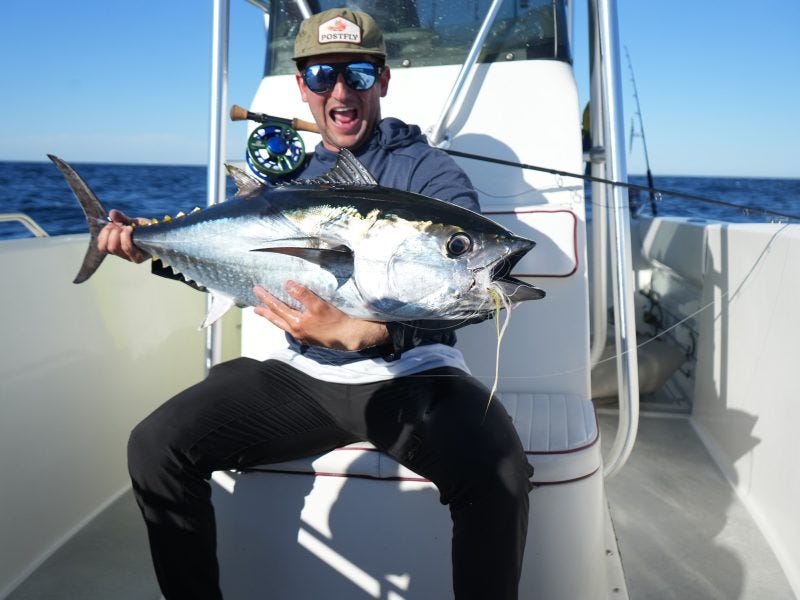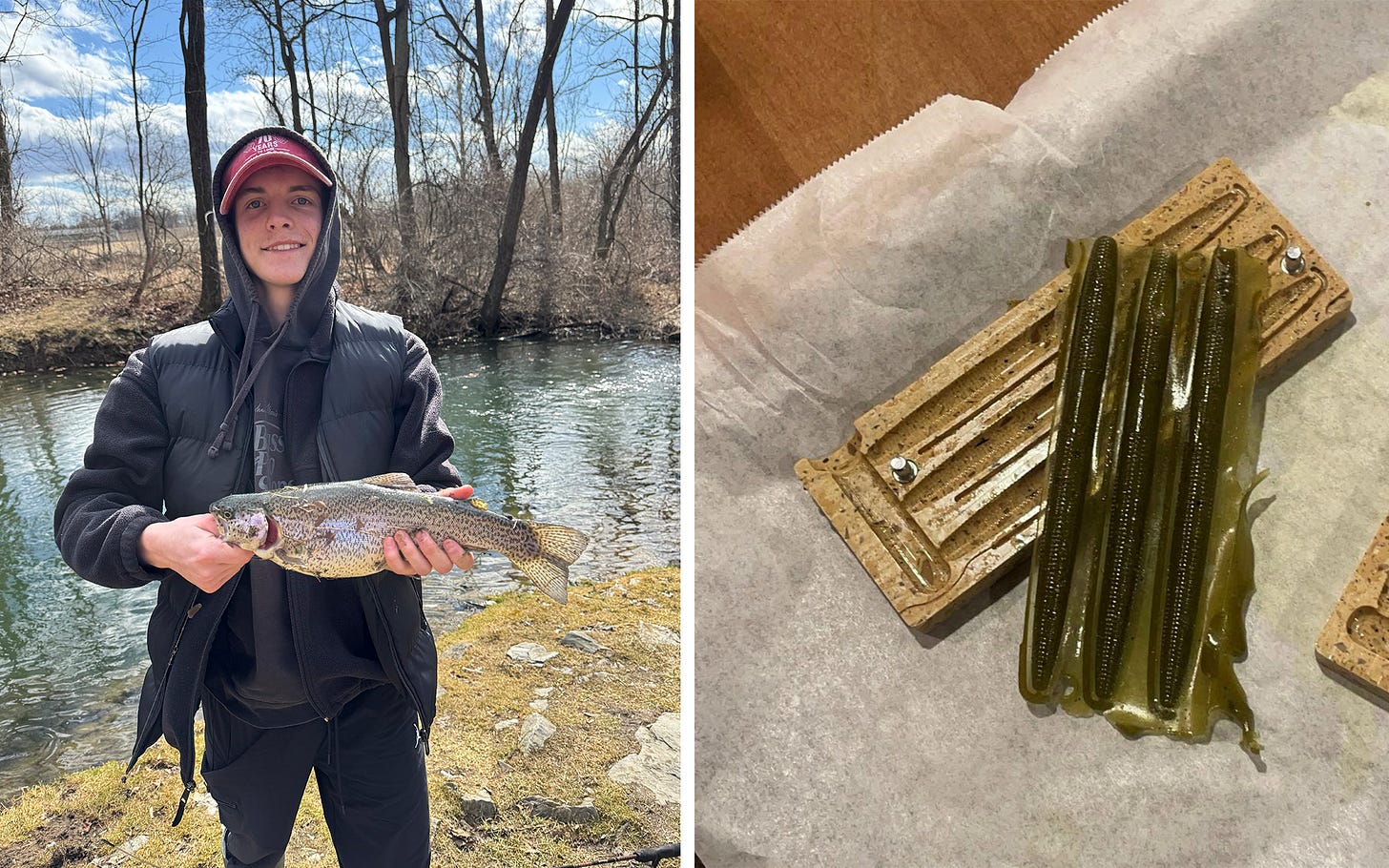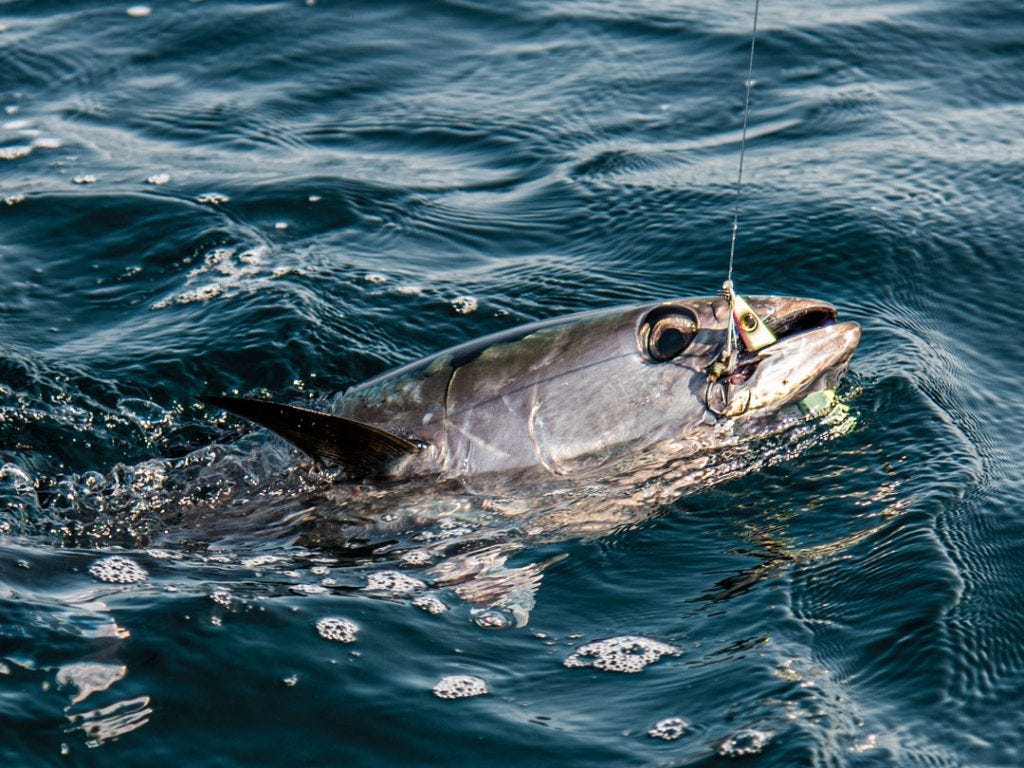The maritime rule of salvage has its origin in Roman law, which dictates that one who preserves or improves upon the misplaced property of another is owed compensation, even if the service was not requested. Let’s get out the internet trawler and get to work…
🎙️| On The Water Podcast - Canyon Running with Captain Deane Lambros —> Deane breaks down the art & science behind high-level charter ops, with plenty of ‘best practice’ tips and tactics to incorporate into your inshore and offshore programs.
Fishing Reports | OnTheWater - FishermanMag - HullTruth - SOL
The Tuna Seminar 2025 - Part Two
Jigging - Mindset and Presentation —> A lot of folks separate jigging from popping but I still consider jigging a “sight fishing” technique. Not only is blind-jigging a wildly inefficient use of your time, but you really shouldn’t differentiate signals on your electronics from those of your eyes, ears, and nose…its all one comprehensive ‘view’ of your environment. Just because the angle of your lines are different doesn’t mean your decision-making process should change. In fact, jigging, popping, and even bait-fishing techniques can all be complementary, and allow multiple anglers to comb different segments of the water column without worrying about a tangle.
This Seven Stripes Podcast w/ Matt Perachio: “Bait-fishing for Bluefin Tuna” is one of better podcast episodes on this topic…Matt’s model for bait-fishing for Bluefin largely expands on the ‘run & gun’ philosophy, finding actively feeding fish and targeting them based on forage and seasonal tendencies…rather than just ‘soaking’ for hours on a historically productive spot. His hybrid bait (and jigging) tactics translate very well to less-structurally oriented drift fishing in CCB, down the backside and south of MV.
This informative video below from The Saltwater Edge expands on the topic as well, emphasizing effective drifts and the different cadences with which you can impart action to your jigs. When primarily jigging, it’s best to start with a variety of retrieves, weights and lure profiles, with the ultimate goal being dialing into the most effective presentation for that day or tide.
Popping Tactics - Approach and Retrieves —> If you’ve been chasing Bluefin for a while or have been reading the Salvage Q&As, you probably know (but might need the reminder) that a critical first step to popping success is actually boat control. Especially around fussy fish and weekend crowds, a methodical approach (consistently from upwind), throttle discipline (a gradual RPM deceleration) and last second rudder adjustments (helping anglers present a bait in front of traveling fish) are essential to success. The next imperative is a leading cast, with a retrieve angle that looks like a naturally fleeing prey item. The perfect sequence is a lure that lands out of sight (but not ear-shot) from a school of tuna, and then works in its designed fashion as the school approaches its location. Here are some of the proven retrieve styles/speeds…
Lure Selection based on tuna behavior —> Most accomplished tuna anglers have ‘confidence baits’ based on seasonal tendencies, location and forage. These baits can generally be broken down into two categories: sight-casting baits and reaction-style baits. Sight-casting baits are utilized when tuna are in sight, plentiful and feeding, and will generally be getting a better look at your bait. They tend to have silent actions, natural colors, are typically smaller or finnesse-y and can be a soft-plastic. Examples include: RonZ, NLBN, Siren Antidote, Hogy Protails, Epoxy Jigs etc. Reaction-baits, on the other hand, are used when you need to ‘draw’ a strike from neutral or non-surface oriented fish. These baits can incorporate rattles, cupped-faces, have ‘loud’ colors (like white/pink/chartreuse), and are generally larger. Think big sliders, poppers, and stick-baits that throw a lot of flash on the sink.
For those wondering about the “why” behind the wiggle and flash of a slider-style plug, look no further than the slow-mo gyration of a flying fish underwater…
‘Kerplunking’ —> This is a hybrid jigging/casting technique that I first learned about from Capt. Mike Hogan at Hogy Lures. It can be very effective around “rafted” shearwaters or Humpback bubble-feeds in an area where tuna are milling but not necessarily actively feeding on the surface. You take a 4-6oz soft-plastic jig and put a long cast into a fishy-looking area and let it "kerplunk" into the mid-water column on semi-slack line. Most bites occur on the initial fall and feel like a subtle ‘tap’. If you don’t get bit on the fall, then use a standard yo-yo retrieve back to the boat.
Rigging Station - Knots, Splices, Crimps, and Rings: One of the greatest barriers to ‘figuring out’ light-tackle tuna is dialing in terminal tackle. Getting rigged up the ‘right way’ is not only going to help you even the odds when bringing a knife to a gunfight, but it’s a critical step towards conserving the incredible fishery we’re blessed with.
Wind-Ons - (video here) - The most versatile (and potentially fastest) connection system. You can buy pre-made wind-on leaders (or make your own) that will be able to connect to hollow-core OR solid-core mainline (via a loop-to-loop + triple-surgeon knot connection), which sounds complicated but the video shows how simple & fast it really is. This makes for very quick re-rigging after a break-off or wind-knot (which is why many charter operations like this system).
FG-Knot - (video here) - Hard to learn but once mastered, it’s probably the most cost-effective and hassle free connection for solid-core braid to mono/flouro. No need to buy or make wind-ons, no needles, bobbin or thread, just tension (and a good pair of gloves) to tighten. I personally like 24-wraps, 6 half-hitches and a rizutto finish with a dab of flexi-glue on the tag end.
On the bitter end —> The general rule of thumb is to crimp your lure on with >150lb leader and use a Palomar, Trilene or SDJ knot (my personal favorite) below 120lb leader material. Those using modern monofilament leaders (like Varivas) have found knots effective up to 170-180lb.
The 'Right Way’ to Rig Jigging Terminal Tackle —> Solid rings, split rings, and power-swivels can be a bit confusing when you’re just getting started…but a visual learning tool can really simplify the word-salad. As we show below, this is the way we (and most light-tackle charters) rig up for jigging BFT. Just remember “one solid, one split, one swivel, one jig.”
Inside the Slimy, Smelly, Secretive World of Glass-Eel Fishing (NewYorker) - “The Sargasso Sea, a warm, calm expanse of the North Atlantic Ocean, is bordered not by land but by four strong currents—a gyre. Vast mats of prickly brown seaweed float so thickly on the windless surface that Christopher Columbus worried about his ships getting stuck. The biodiverse sanctuary within and beneath the sargassum produces Anguilla rostrata, the American eel. Each female lays some eight million eggs. The eggs hatch as ribbonlike larvae that drift to the Gulf Stream, which carries them to the continental shelf. By the time they reach Maine, the larvae have transformed into swimmers about the length of an index finger, with the circumference of a bean sprout and the translucence of a jellyfish. Hence their nickname, glass eels, also known as elvers. The glass eel is barely visible, but for a dark stripe—its developing backbone—and a couple of chia seeds for eyes.”
NOAA Adjusts Bluefin Tuna Limits Again (OnTheWater) - Private vessels with an HMS Angling permit can now retain 1 bluefin tuna measuring 27” to <73”. Charter/Headboats can now retain 2 bluefin tuna measuring 27” to <73”, only 1 of which may be in the 47” to <73” range. —> Thank you to all those who helped organize a response and sent emails to NOAA reps! This is a big win for stakeholders like us and proof that grassroots response can change the narrative around conservation and regulation!
Angler Wins His Science Fair for Biodegradable Fishing Lures (OutdoorLife) - “Albright’s bioplastic project is encouraging for more eco-conscious anglers, since plastic is one of the most impactful and prevalent pollutants in our waterways today. It can persist in the environment for hundreds or even thousands of years, where it fragments into smaller and smaller pieces (aka microplastics) that are invisible to the human eye but harmful to living organisms. Researchers and healthcare professionals are only beginning to understand the impacts that microplastics are having on our oceans, lakes and rivers, and our own health — along with that of our fish and wildlife.”
Oldie but Goodie: Tiny Tuna Tactics - A Bag Of Tricks (FishermanMag) - “Trolling can be a very relaxing way to fish. Along with being relaxing, you are able to cover a lot of ground searching for fish. However, there are times when it just makes a lot of sense to put the trolling gear away and start to jig and pop. Once we hook up, or have pinpointed where the bait and fish are located, we put away our trolling gear and start to jig and pop. Sometimes it is all “unders,” but just because we are catching “unders” it doesn’t mean that bigger fish aren’t among them. I remembered reading that big bluefin and yellowfin will often hang underneath schools of skipjack tuna. As I’m heading over to the skippies, my buddy who was fishing within eyesight of us hails me on the radio and tells me they just had a big bluefin come up and “nose” a popping plug. That got me excited so I grabbed a popping outfit and handed it to my buddy Chris. While he worked the popper, the other guys continued to jig. I just stared at the popper as Chris worked it along the surface and then it happened.”
Looking for more information about a product after reading The Weekly Salvage?
Try using GearSay, the first generative AI tool specifically tailored to help you find the right fishing tackle.
Thanks for reading The Weekly Salvage, until next week!
Have feedback or want to learn more?
Reach out to us on IG @Blowin_We_Goin

